Whether you are remodeling an owner's suite or powder room, picking the perfect tile for your bathroom can be challenging. After all, there are dozens of styles, finishes, materials, shapes and sizes to choose from. When choosing tiles for your bathroom floor or bathroom walls, be sure to consider both aesthetics and performance. Most bathrooms are high-traffic areas exposed to wild swings in temperature and humidity. As such, the right tile for your bathroom will be durable, easy to clean and resistant to mold or mildew. It will have some grip to prevent seniors, children and residents with mobility challenges from slipping. For many homeowners, the right type of floor tile or wall tiles in their bathroom will also be affordable to source, install and maintain. In this post, we answer ten questions frequently asked by homeowners hoping to remodel their bathrooms. Follow below to learn everything you need to know about selecting tiles for your bathroom and when to call on a professional for help. For more information, refer to our Bathroom Remodeling resource here.
10 FAQs About Choosing Bathroom Tile
#1 What Are The Different Types of Bathroom Tile?
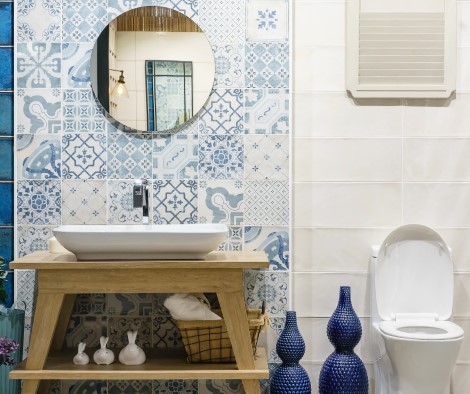 There are more than a dozen different types of bathroom tiles. These include porcelain tile, ceramic tile, glass tile, mosaic tile, metal tile, cement tile, peel-and-stick vinyl tile, terracotta tile and vitrified tile. Natural stone tiles made from marble, granite, limestone, slate and travertine are also popular, though they are typically more expensive than those listed above.
There are more than a dozen different types of bathroom tiles. These include porcelain tile, ceramic tile, glass tile, mosaic tile, metal tile, cement tile, peel-and-stick vinyl tile, terracotta tile and vitrified tile. Natural stone tiles made from marble, granite, limestone, slate and travertine are also popular, though they are typically more expensive than those listed above.
The perfect bathroom tile for your remodeling project will depend on your budget, aesthetic preferences and lifestyle. The size and function of your space could also play a part. For example, some tiles are perfect for powder room walls that stay fairly dry but are totally inappropriate for a shower floor. We explain this in further detail below.
#2 What Are The Different Shapes of Tiles?
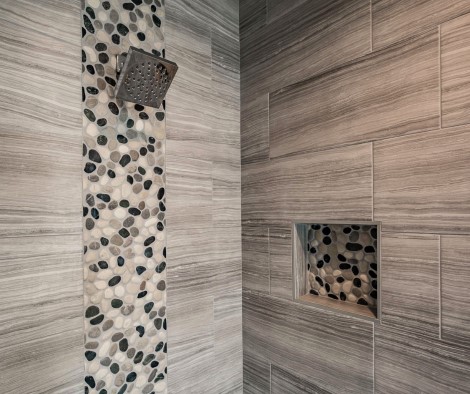 In her article “Tile Talk” for Dwell, Kate Reggev identifies the most popular shapes of bathroom tile as penny or circular, square, subway and plank. However, there are many other shapes available. These include kite, diamond, hexagon, ellipse, teardrop, oval, octagon, fish scale, fan, petal and dogbone.
In her article “Tile Talk” for Dwell, Kate Reggev identifies the most popular shapes of bathroom tile as penny or circular, square, subway and plank. However, there are many other shapes available. These include kite, diamond, hexagon, ellipse, teardrop, oval, octagon, fish scale, fan, petal and dogbone.
Keep in mind that bathroom tiles can be laid in a number of different patterns. For example, classic subway tiles need not be laid in their traditional horizontal brick bond formation. Instead, your remodeler could lay subway tile in a chevron, herringbone or basketweave pattern.
#3 Which Bathroom Tiles Are Most Affordable?
When determining which bathroom tiles are most affordable, one must consider the purchase price, installation cost and cost to maintain each type. The tile size, material and shape could affect each of these costs, as could the source location. Ceramic, porcelain, vinyl and glass tiles are usually less expensive to purchase, install and maintain than natural stone tiles. In her article “Porcelain vs. Ceramic: How to Decide Which Tile Type Is Best for You” for Better Homes & Gardens, Jessica Bennett explains. According to Bennett, both porcelain and ceramic are “clay-based, kiln-fired tiles [that] are extremely durable, easy to clean, and resistant to water, stains, and daily wear.”
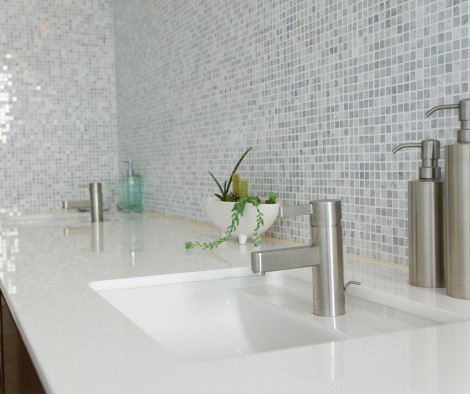 Porcelain is especially cost-effective. Quoting kitchen and bath designer Tanya Woods, Bennett writes that “‘porcelain is really making its mark on the industry’” because it is well suited to all climates and nearly all use cases. Class 3, 4 and 5 porcelain tiles can withstand extreme temperatures and medium to extra-heavy traffic. Porcelain tiles are also “less likely to crack and [are] more impervious to stains” than ceramic, glass and natural stone tiles.
Porcelain is especially cost-effective. Quoting kitchen and bath designer Tanya Woods, Bennett writes that “‘porcelain is really making its mark on the industry’” because it is well suited to all climates and nearly all use cases. Class 3, 4 and 5 porcelain tiles can withstand extreme temperatures and medium to extra-heavy traffic. Porcelain tiles are also “less likely to crack and [are] more impervious to stains” than ceramic, glass and natural stone tiles.
Professional installation is usually recommended for ceramic, porcelain, glass and natural stone tiles. Keep this in mind when picking bathroom tile for your home. Penny tiles, vinyl tiles and other tiles backed with a sheet of adhesive are easiest to install without the aid of a professional. Small tiles laid in a pattern, tiles made from a delicate material, tiles that are particularly heavy and extra large slab tiles are all more expensive and more difficult to install.
Which Tiles Are Most Expensive?
Of all the many bathroom tile options available, those made from natural stone are usually most expensive to buy, install and care for. Types of stone commonly used in bathroom and kitchen tiles include marble, granite, slate, travertine, slate and limestone. Natural stone is usually more expensive than ceramic, porcelain, glass, metal and vinyl because it is heavy, delicate and difficult to cut.
There are a couple exceptions. For example, limestone and travertine are two of few natural stones that are easy to cut into various shapes and patterns – though both are still quite expensive. Granite is not as easy to cut but is much cheaper than marble and slate.
Most natural stone tiles also require more prep work before installation. Because of the sheer weight of most natural stone tiles, they need a firmer subfloor than porcelain, ceramic and vinyl. In her article “The 12 Different Types of Tiles, Explained by Pros” for RealSimple, Wendy Rose Gould outlines other costs associated with stone tile. Quoting Tony Castellano – who is senior merchant for The Home Depot – Gould writes that natural stone “requires a lot of upkeep to keep it looking pristine.”
Most stone tiles are “susceptible to scratches and stains in addition to being difficult to clean.” Certain natural stone tiles – like travertine and limestone – are porous. This means that they absorb oils and dirt, scratch easily and could crack or crumble. For this reason, porous stones are not used in countertops or floors very often but might be used in a vanity backsplash or on shower walls. Nearly all tiles of natural stone require regular sealing, a tile project usually undertaken by a professional remodeler or contractor. Be sure to consider this when choosing bathroom tiles.
#4 Which Bathroom Tiles Are Most Popular?
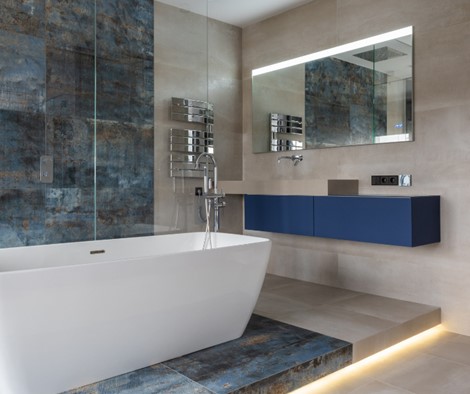 Because ceramic tile and porcelain tile are less expensive and easier to clean than natural stone, they are incredibly popular amongst both remodelers and homeowners. Glass is also popular but can chip easily, making it less common. Homeowners often prefer porcelain to glass and ceramic because it can be manufactured to mimic the appearance of brick, natural stone and other desirable materials. Porcelain can also be used outdoors, making it ideal for exterior showers near a beach or pool. Households with elderly family members or young children might avoid ceramic, porcelain and/or glass because all can be quite cold and slippery. In some cases, this could be dangerous for residents.
Because ceramic tile and porcelain tile are less expensive and easier to clean than natural stone, they are incredibly popular amongst both remodelers and homeowners. Glass is also popular but can chip easily, making it less common. Homeowners often prefer porcelain to glass and ceramic because it can be manufactured to mimic the appearance of brick, natural stone and other desirable materials. Porcelain can also be used outdoors, making it ideal for exterior showers near a beach or pool. Households with elderly family members or young children might avoid ceramic, porcelain and/or glass because all can be quite cold and slippery. In some cases, this could be dangerous for residents.
Vinyl tiles are also popular but not as versatile. Unlike ceramic, porcelain, glass and natural stone, vinyl tiles are rarely used on backsplashes, shower walls or bathroom walls. Using vinyl tile as a decorative accent tile is also unusual. Though vinyl tiles are not as elegant as porcelain, ceramic or glass, they are incredibly inexpensive, easy to clean and simple to install on your own. In her article “The Best Flooring Options for Bathrooms” for This Old House, Nancy Fann-Im explains. Fann-Im writes that “vinyl has surged in popularity as a bathroom flooring material…over the last decade.”
Today, vinyl flooring is available in hundreds of patterns, colors and shapes. Shoppers can buy vinyl as “sheets, planks, or tiles, with sheets being the best option for bathrooms because the installation is virtually seamless.” Seamless installation is appealing to DIY remodelers but might not give every homeowner the look they are going for. For example, you cannot customize the thickness of grout lines or the grout color when working with linoleum or vinyl floor tiles.
#5 Which Bathroom Tiles Are Easiest to Keep Clean?
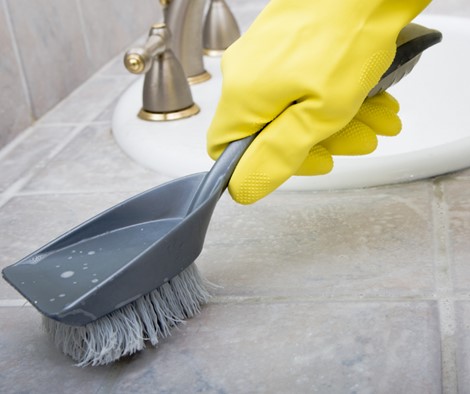 Referencing a survey conducted last year by Statista in her article for Angi, “80% of Americans will spend nearly a year of their life doing chores.” Most household chores are incredibly time-consuming but few are hated as much as cleaning bathrooms. According to ACI's 2018 National Cleaning Survey, 52% of respondents dread cleaning their bathrooms more than any other cleaning task.
Referencing a survey conducted last year by Statista in her article for Angi, “80% of Americans will spend nearly a year of their life doing chores.” Most household chores are incredibly time-consuming but few are hated as much as cleaning bathrooms. According to ACI's 2018 National Cleaning Survey, 52% of respondents dread cleaning their bathrooms more than any other cleaning task.
Given this, it makes sense to choose floor, wall and backsplash tiles that are easy to clean as well as resistant to smudging, mould and mildew. Of course, some materials, finishes and styles are easier to clean than others. In general, larger tiles made from smooth sealed materials – like porcelain, ceramic and glass – are easiest to clean. Larger tiles are typically easier to clean than smaller tiles because they have fewer grout lines.
Glossy tiles are also easier to clean than matte tiles, though homeowners should avoid high-shine finishes. On the other hand, high-shine finishes show soap scum more readily than medium gloss and can be slippery when wet. Similarly, light colored tiles are easier to clean than dark tiles because splatter, smudges and scum are more visible on black and gray tiles.
Stone is perhaps the most difficult material to clean. Anabelle Bernard Fournier, author for The Spruce explains, “each stone will need a different type of cleaning routine.” For example, Fournier notes that “more porous stones such as marble or soapstone, require a regular sealant treatment to keep them stain- and humidity-resistant.”
#6 Is It Better to Use Small or Large Scale Tiles in a Bathroom?
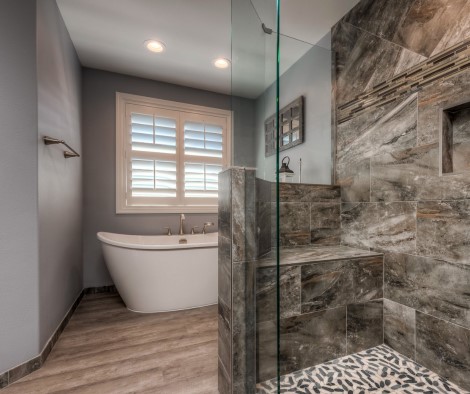
Above is an after photo of the owner’s suite bathroom remodel in one client’s Mill Creek, Washington house. As you can see, our team opted for three sizes of tiling in this cozy space: wide plank rectangles, razor-thin rectangles and small-scale ovals. Our team laid the larger tiles in two different patterns: horizontal and diagonal. Because the design scheme of this remodeled bathroom is fairly monochromatic, our team was free to play with texture, shape and scale when choosing tiles.
Like our team opted to do in the Mill Creek remodel, designers often recommend a small scale tile for bathroom floors because larger tiles can get slippery much more easily. In his article “Bathroom Tile Size Advice: Floors, Walls, Showers & Tubs” for The Spruce, Lee Wallender elaborates. According to Wallander, “smaller size tiles work better for shower flooring because they create better grip opportunities for your feet.” Smaller tiles usually have more grout lines, which “can provide much-needed friction when your feet are moving around on wet flooring.”
Will Large Tiles Work in a Small Bathroom?
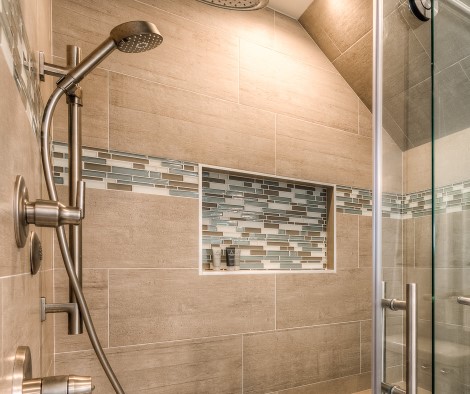 Homeowners might assume that choosing small tiles for a large bathroom and large tiles for a small bathroom are both mistakes. However, this is often untrue. In her article “How to choose bathroom tiles – find the best ones to suit your bathroom space” for Real Homes, Sarah Warwick explains. Warwick writes that “tile size shouldn’t be determined by bathroom size, despite what you may hear.” According to Warwick, “a small bathroom can actually benefit from a large tile,” especially when paired with smaller scale tiles as pictured above. Large tiles work well in small bathrooms because there are “fewer grout lines” to distract viewers.
Homeowners might assume that choosing small tiles for a large bathroom and large tiles for a small bathroom are both mistakes. However, this is often untrue. In her article “How to choose bathroom tiles – find the best ones to suit your bathroom space” for Real Homes, Sarah Warwick explains. Warwick writes that “tile size shouldn’t be determined by bathroom size, despite what you may hear.” According to Warwick, “a small bathroom can actually benefit from a large tile,” especially when paired with smaller scale tiles as pictured above. Large tiles work well in small bathrooms because there are “fewer grout lines” to distract viewers.
Opting for a large scale tile on the bathroom floor or shower walls while choosing a smaller scale as accent tiles around the vanity can work wonders in a cozy space.
Keep in mind that a small bathroom might not be able to accommodate very many large format tiles. This might mean cutting down a number of tiles to fit the space, which could be very costly if you choose a brittle material like marble.
The Growing Popularity of Large Format Tiles in Single Family Homes
Regardless, large format tiles are modern, easy to clean and incredibly popular in 2022. In her article “When Bigger Is Better: The Dramatic Look of Large-Format Tiles” for Houzz, San Francisco-based designer Barbra Bright writes that large format tiles were “originally limited to commercial venues like hotels and restaurants” for these reasons. However, they recently escaped commercial venues and found their way into single family homes. Bright writes that “large-format tiles offer a clean, sleek, modern aesthetic, but they can also work well with traditional decor.”
Large format tiles are super versatile and “are available in a variety of materials, including natural stone, glass and porcelain.” Remodelers and contractors can install large format tiles on floors and walls. The latter is even more popular. It works well as a replacement for wallpaper or paint that might buckle or peel when exposed to high heat and relative humidity. One complication to consider before choosing large format tiles is that your bathroom floor or walls must be perfectly flat for a seamless installation. Any disruption will prevent the tiles from matching up. While this is not a big deal when installing small scale tiles, it simply will not work when installing large format tiles.
#7 What Is The Best Grout for Bathroom Tiles?
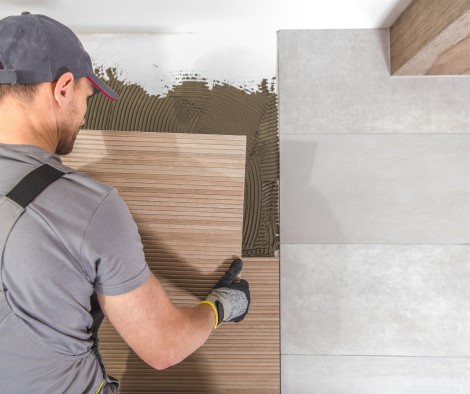 Unless you opt for vinyl planks when choosing bathroom tile, you or your remodeler will probably use grout. There are many different finishes, grits and colors of grout. You might choose a grout based solely on aesthetic preferences. For example, some homeowners prefer a wide network of grout lines while others prefer as few lines as possible so as not to distract from the tiles themselves. Some homeowners like thin grout lines while others like thick grout lines.
Unless you opt for vinyl planks when choosing bathroom tile, you or your remodeler will probably use grout. There are many different finishes, grits and colors of grout. You might choose a grout based solely on aesthetic preferences. For example, some homeowners prefer a wide network of grout lines while others prefer as few lines as possible so as not to distract from the tiles themselves. Some homeowners like thin grout lines while others like thick grout lines.
However, different grout formulations are better suited to certain tile projects, which is why consulting with a professional remodeler is important. Your remodeler will know when to use sanded grout and when to use unsanded grout. He or she will know when to apply cement based grout versus epoxy grout – and so on.
Choosing the Right Grout for Your Bathroom Tiles
As mentioned above, you and your remodeler must decide on the grout color and thickness that looks best with the tile you have chosen. In the article “Pros & Cons: Dark Grout in the Bathroom” for Apartment Therapy, Liana Hayles Newton offers her advice. Newton writes that “using a light colored grout, particularly in conjunction with white tiles, can produce a bright, clean look, but it is a very high maintenance choice.”
Both thick grout lines and bright white grout lines are difficult to clean. Pairing a white grout with white tiles is often a losing battle – particularly if you choose a durable, stain resistant tile like porcelain or ceramic. The ceramic and/or porcelain will not discolor but the grout probably will. This can turn a once flawless all-white space into one that looks grimy and disjointed.
On the other hand, “choosing a grout that is darker in color helps conceal dirt and is less likely to change in color as quickly as a light colored grout.” Dark grout can also provide contrast and “enhance the look of the bathroom.” However, dark grout is more prone to fading than light grout. Newton notes that darker grout “can lose its color when cleaned with products that are too harsh or with tools that are too abrasive.”
#8 Are Dark or Light Colored Tiles Better for a Bathroom?
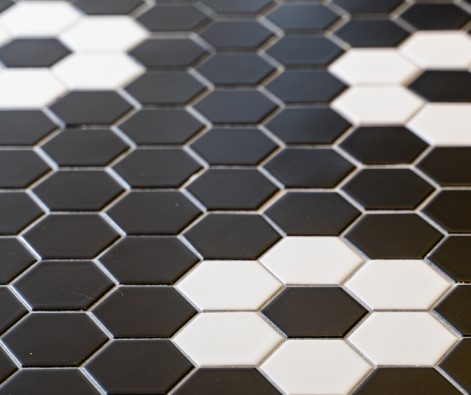 When choosing a bathroom tile color, homeowners are often caught between light and dark colored tiles. Pale colors create a serene space while darker tones add depth and drama. Bright white tile can feel either clinical or contemporary and black tile can feel either sophisticated or too intense. Which bathroom tile colors you choose will depend largely on your personal style as neither light nor dark colors are restricted to small, large, modern or traditional spaces. As you choose bathroom tiles, just remember that dark tiles tend to show dirt, soap scum and dust more readily than light tiles.
When choosing a bathroom tile color, homeowners are often caught between light and dark colored tiles. Pale colors create a serene space while darker tones add depth and drama. Bright white tile can feel either clinical or contemporary and black tile can feel either sophisticated or too intense. Which bathroom tile colors you choose will depend largely on your personal style as neither light nor dark colors are restricted to small, large, modern or traditional spaces. As you choose bathroom tiles, just remember that dark tiles tend to show dirt, soap scum and dust more readily than light tiles.
Keep in mind that you need not limit yourself to just one color when choosing bathroom tile. In fact, using the same tile everywhere in your bathroom can make the space seem small and one-dimensional. As long as you establish a color palette and refrain from deviating too far from your theme, you can include a number of bathroom tile colors. If you choose a dark floor tile or wall tile for a small bathroom, consider glossy tiles to help bounce light around the room. This makes the space appear larger as long as not all tiled walls and floors are high shine.
#9 Can You Heat Tile Floors?
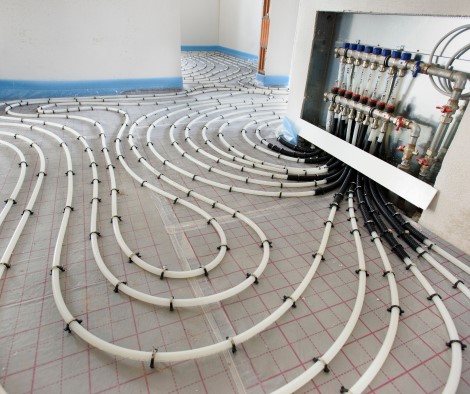 Whether they are made from glass, porcelain, ceramic or natural stone, tile floors tend to feel quite cold underfoot. While lovely in the summertime, this can be quite jarring in the winter. To avoid a shock when stepping out of the shower, some homeowners ask their remodelers to install radiant heating. But can you heat tile floors? The short answer is yes.
Whether they are made from glass, porcelain, ceramic or natural stone, tile floors tend to feel quite cold underfoot. While lovely in the summertime, this can be quite jarring in the winter. To avoid a shock when stepping out of the shower, some homeowners ask their remodelers to install radiant heating. But can you heat tile floors? The short answer is yes.
In his article “Electric Radiant Floor Heating: The Basics” for The Spruce, Lee Wallender explains that most tile floors are actually ideal candidates for underfloor heating. According to Wallender, radiant floor heating systems “are especially effective on flooring surfaces that are naturally cool to the touch, such as stone, concrete, or ceramic tile.” In fact, radiant floor heating systems are much “less effective under carpeting, hardwood or vinyl since heat can be trapped between the insulating surface layer and subfloor.”
#10 Should You Choose a Glossy or Matte Finish for Bathroom Tile?
Last on our list of frequently asked questions about how to select tiles for a bathroom is if you should choose a glossy or matte finish. We addressed this briefly earlier on in the post. We noted that glossy tiles tend to conceal splatter and scratches and are usually easier to clean. However, a super high-shine finish can actually draw attention to damage.
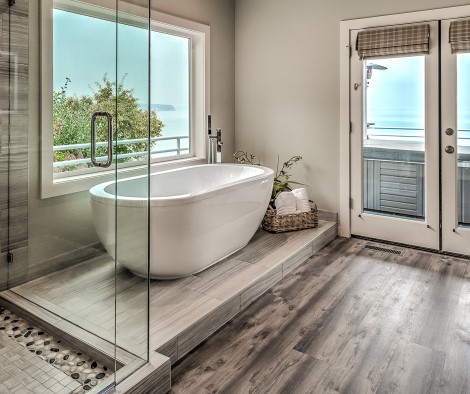 Grace de Asis explains when to use matte versus glossy tile in her article “4 ‘Rules’ You Need to Know Before Picking Tile for Your Bathroom or Kitchen Reno” that, “matte (or honed) tiles are a go-to for flooring, especially in wet areas, because of their non-skid, non-slip properties.” Glossy tiles can be slippery and might be better suited to backsplashes (as pictured above) and other “splash zone” areas of your bathroom.
Grace de Asis explains when to use matte versus glossy tile in her article “4 ‘Rules’ You Need to Know Before Picking Tile for Your Bathroom or Kitchen Reno” that, “matte (or honed) tiles are a go-to for flooring, especially in wet areas, because of their non-skid, non-slip properties.” Glossy tiles can be slippery and might be better suited to backsplashes (as pictured above) and other “splash zone” areas of your bathroom.
Working with Snohomish County Bathroom Remodelers VanderBeken Remodel
Homeowners across Washington State often turn to the team at VanderBeken Remodel for all sorts of renovations. However, our design-team specializes in kitchen, whole home and bathroom remodels. Check out some of our past owner suite remodels here and hall bathroom remodels here. If you live in Everett, Marysville, Mill Creek, Mukilteo or elsewhere in Snohomish County, Washington and are planning a bathroom remodeling project, reach out to our team for help!



